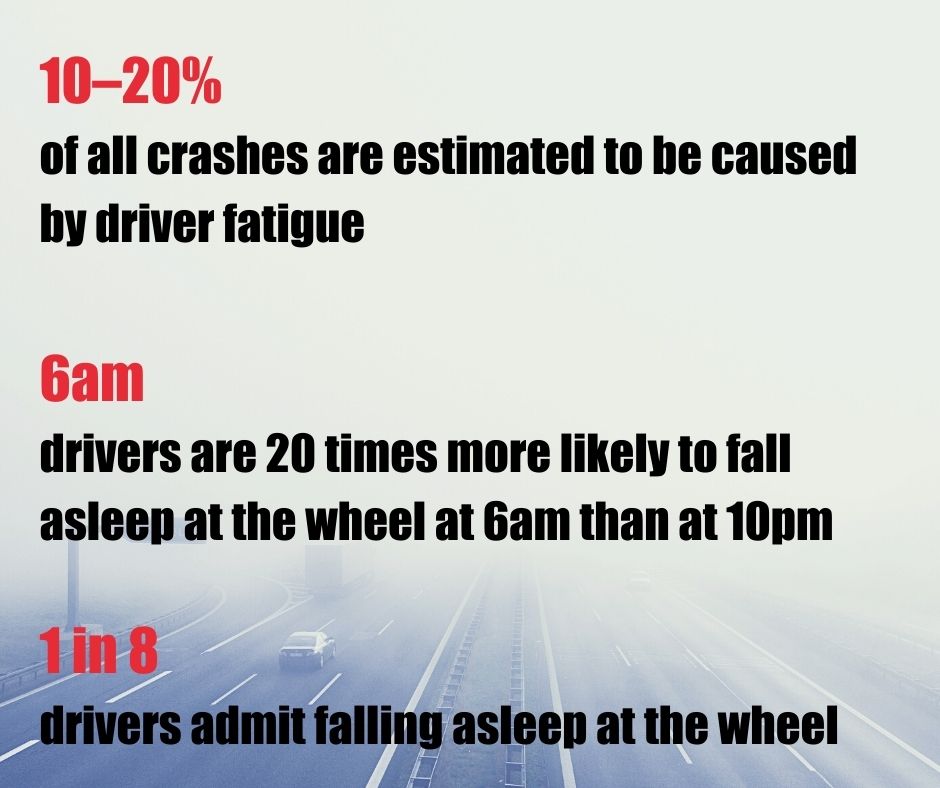Topics
Courses and training
Road safety advice

 Fatigue is a major cause of road crashes and could be as dangerous as drink-driving.
Fatigue is a major cause of road crashes and could be as dangerous as drink-driving.
Tired drivers have slower reaction times, suffer from reduced attention, awareness, and ability to control their vehicles.
In this fact page we cover:
-
Risks associated with driving when tired
-
Causes of fatigue
-
Ways to reduce the risk of driving when tired
Police statistics show that fatigue contributes to about 4 per cent of fatal road crashes and 2 per cent of all collisions in Britain. However, it is likely that the true figures are far higher because fatigue is hard to spot and, unlike alcohol and drugs, police can’t test for tiredness.
Worldwide, it is estimated that between 10 per cent and 20 per cent of all road crashes are fatigue related.
Most sleep-related crashes happen on motorways and dual-carriageways, probably because of the monotonous road environment and lack of driver stimulation.
Crashes typically involve vehicles running off the road or into the back of another vehicle. They tend to happen at high speeds, because drivers do not brake before crashing, so the risk of death or serious injury is high.

Factors that contribute to driver fatigue:
Many factors can contribute to driver tiredness and increase the risk of being involved in a fatigue related crash.
These include:
Lack of sleep or disturbed sleep: This could be due to disruptions in life such as a new baby, busy schedules or stress, or could be due to sleep disorders such as narcolepsy, insomnia or sleep apnoea.
Time of day: The most common times for drivers with normal sleep patterns to fall asleep at the wheel are early morning (2am-6am) and early afternoon (2pm-4pm). These times are when the body clock reaches a natural dip, causing drowsiness and reduced concentration.
Stress: Tiredness and difficulty concentrating are typical symptoms of stress.
Irregular sleep patterns: This can be a problem caused by irregular work shifts and switching from day to night shifts without having sufficient time off in between for your body clock to adjust. Research has found shift workers are particularly high risk for sleep-related crashes.
Driving for long periods: Research has found driving deteriorates after two hours of continuous driving, as you become less able to concentrate, and slower to react to hazards. The longer you drive, the more rest you need to recover driving performance. Breaks are therefore recommended every two hours.
Vehicle engineering: Modern vehicles are usually quiet and comfortable for the driver, meaning a more relaxed drive. This can lull drivers, particularly in vehicles fitted with comfort-enhancing features such as cruise control.
Medication: Some prescription and over-the-counter drugs can cause drowsiness. Medications may carry warnings that are not clear they impair driving, for example small print that only advises not to operate heavy machinery.
Signs of fatigue
Fatigue does not occur without warning, and most people recognise the symptoms but many still underestimate the dangers of continuing to drive while tired.
Warning signs include:
-
increased difficulty concentrating
-
yawning
-
heavy eyelids
-
eyes starting to ‘roll’
-
nodding head
Who is most at risk of driver fatigue?
At-work drivers are particularly at risk from tiredness, because they typically spend longer hours at the wheel, with four in ten tiredness-related crashes involving someone driving a commercial vehicle.
Male drivers are more likely to experience sleep-related crashes than females. Drivers under 30 are at higher risk than older drivers and are most likely to crash due to tiredness in the early morning after little or no sleep.
How to manage the risks associated with driver fatigue:
-
Tell your boss and/or doctor about health problems that affect your sleep
-
Aim for a minimum of 7-8 hours of sleep each night
-
Make sure you take enough breaks while driving – at least every two hours
Thanks to Brake for the above information.
This link will take you through to the Brake website where you can find out more about driver fatigue.
For further information about SYSRP and our campaigns and initiatives, or if you have any queries, then contact us using this form or drop an email to enquiries@sysrp.co.uk.
To keep up-to-date with our many events and initiatives around South Yorkshire then follow us @SYSaferRoads.








